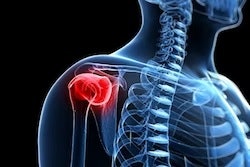Wednesday, December 4 | 3:00 p.m.-3:10 p.m. | SSM17-01 | Room S105AB
Is saline or gadolinium the best option for an MR arthrogram to detect labral and rotator cuff injuries in the shoulder?To address that question, a team led by Dr. Adam Singer, an assistant professor of radiology at Emory University, conducted a retrospective study of patients who were referred over the course of 18 months for shoulder issues. A musculoskeletal radiologist confirmed the injection of either saline or gadolinium for the MR arthrogram.
The researchers analyzed a total of 34 gadolinium arthrograms and 24 saline arthrograms and compared the results with surgical arthroscopic findings as the reference standard. The rotator cuff and the long head of the biceps tendon were classified as having a full- or partial-thickness tear, as having tendinosis or low-grade fraying, or as being normal. The labrum was classified as having a tear; having fraying, blunting, or degeneration; or as normal. From there, the diagnostic performance of each contrast agent was calculated.
Overall, "saline performed at least as well as gadolinium for the diagnosis of surgically proven rotator cuff tears," Singer and colleagues wrote in their abstract. "Saline was noninferior in the detection of anterior and posterior labral tears."
The bottom line is that saline should be considered for some MR arthrograms, and it could help imaging centers save money via faster scan times and the ability to skip gadolinium-based contrast, according to the researchers.



.fFmgij6Hin.png?auto=compress%2Cformat&fit=crop&h=100&q=70&w=100)




.fFmgij6Hin.png?auto=compress%2Cformat&fit=crop&h=167&q=70&w=250)











